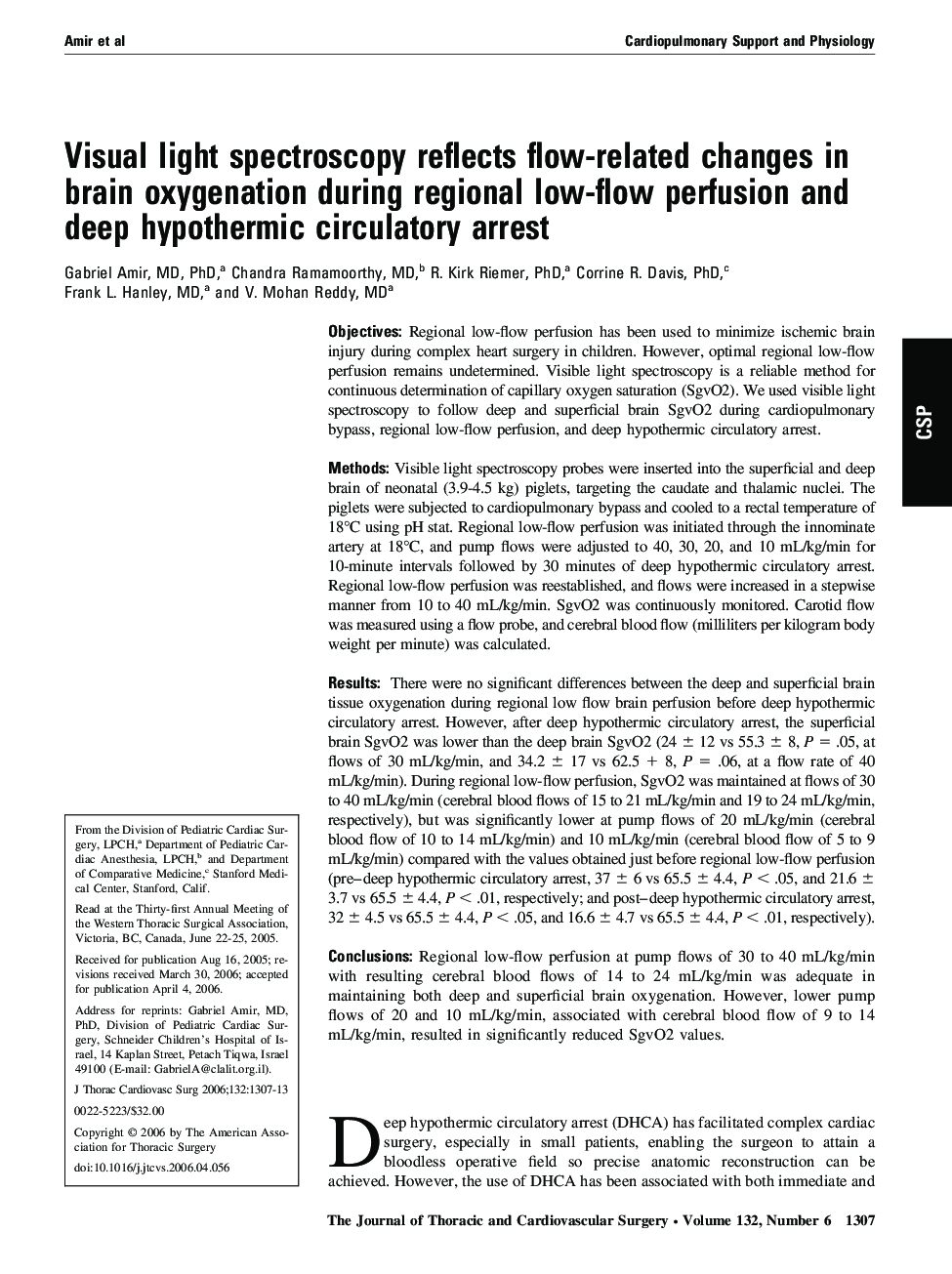| کد مقاله | کد نشریه | سال انتشار | مقاله انگلیسی | نسخه تمام متن |
|---|---|---|---|---|
| 2987115 | 1578703 | 2006 | 6 صفحه PDF | دانلود رایگان |

ObjectivesRegional low-flow perfusion has been used to minimize ischemic brain injury during complex heart surgery in children. However, optimal regional low-flow perfusion remains undetermined. Visible light spectroscopy is a reliable method for continuous determination of capillary oxygen saturation (SgvO2). We used visible light spectroscopy to follow deep and superficial brain SgvO2 during cardiopulmonary bypass, regional low-flow perfusion, and deep hypothermic circulatory arrest.MethodsVisible light spectroscopy probes were inserted into the superficial and deep brain of neonatal (3.9-4.5 kg) piglets, targeting the caudate and thalamic nuclei. The piglets were subjected to cardiopulmonary bypass and cooled to a rectal temperature of 18°C using pH stat. Regional low-flow perfusion was initiated through the innominate artery at 18°C, and pump flows were adjusted to 40, 30, 20, and 10 mL/kg/min for 10-minute intervals followed by 30 minutes of deep hypothermic circulatory arrest. Regional low-flow perfusion was reestablished, and flows were increased in a stepwise manner from 10 to 40 mL/kg/min. SgvO2 was continuously monitored. Carotid flow was measured using a flow probe, and cerebral blood flow (milliliters per kilogram body weight per minute) was calculated.ResultsThere were no significant differences between the deep and superficial brain tissue oxygenation during regional low flow brain perfusion before deep hypothermic circulatory arrest. However, after deep hypothermic circulatory arrest, the superficial brain SgvO2 was lower than the deep brain SgvO2 (24 ± 12 vs 55.3 ± 8, P = .05, at flows of 30 mL/kg/min, and 34.2 ± 17 vs 62.5 + 8, P = .06, at a flow rate of 40 mL/kg/min). During regional low-flow perfusion, SgvO2 was maintained at flows of 30 to 40 mL/kg/min (cerebral blood flows of 15 to 21 mL/kg/min and 19 to 24 mL/kg/min, respectively), but was significantly lower at pump flows of 20 mL/kg/min (cerebral blood flow of 10 to 14 mL/kg/min) and 10 mL/kg/min (cerebral blood flow of 5 to 9 mL/kg/min) compared with the values obtained just before regional low-flow perfusion (pre–deep hypothermic circulatory arrest, 37 ± 6 vs 65.5 ± 4.4, P < .05, and 21.6 ± 3.7 vs 65.5 ± 4.4, P < .01, respectively; and post–deep hypothermic circulatory arrest, 32 ± 4.5 vs 65.5 ± 4.4, P < .05, and 16.6 ± 4.7 vs 65.5 ± 4.4, P < .01, respectively).ConclusionsRegional low-flow perfusion at pump flows of 30 to 40 mL/kg/min with resulting cerebral blood flows of 14 to 24 mL/kg/min was adequate in maintaining both deep and superficial brain oxygenation. However, lower pump flows of 20 and 10 mL/kg/min, associated with cerebral blood flow of 9 to 14 mL/kg/min, resulted in significantly reduced SgvO2 values.
Journal: The Journal of Thoracic and Cardiovascular Surgery - Volume 132, Issue 6, December 2006, Pages 1307–1312